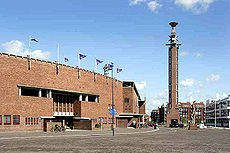
Back مدرسة أمستردام Arabic Escola d'Amsterdam (arquitectura) Catalan Amsterdamská škola Czech Amsterdamer Schule (Architektur) German Amsterdama skolo Esperanto Escuela de Ámsterdam Spanish Amsterdamin koulukunta Finnish École d'Amsterdam French Amsterdamske Skoalle (boustyl) Frisian אסכולת אמסטרדם HE
This article needs additional citations for verification. (April 2020) |







The Amsterdam School (Dutch: Amsterdamse School) is a style of architecture that arose from 1910 through about 1930 in the Netherlands. The Amsterdam School movement is part of international Expressionist architecture, sometimes linked to German Brick Expressionism.
Buildings of the Amsterdam School are characterized by brick construction with complicated masonry with a rounded or organic appearance, relatively traditional massing, and the integration of an elaborate scheme of building elements inside and out: decorative masonry, art glass, wrought ironwork, spires or "ladder" windows (with horizontal bars), and integrated architectural sculpture. The aim was to create a total architectural experience, interior and exterior.